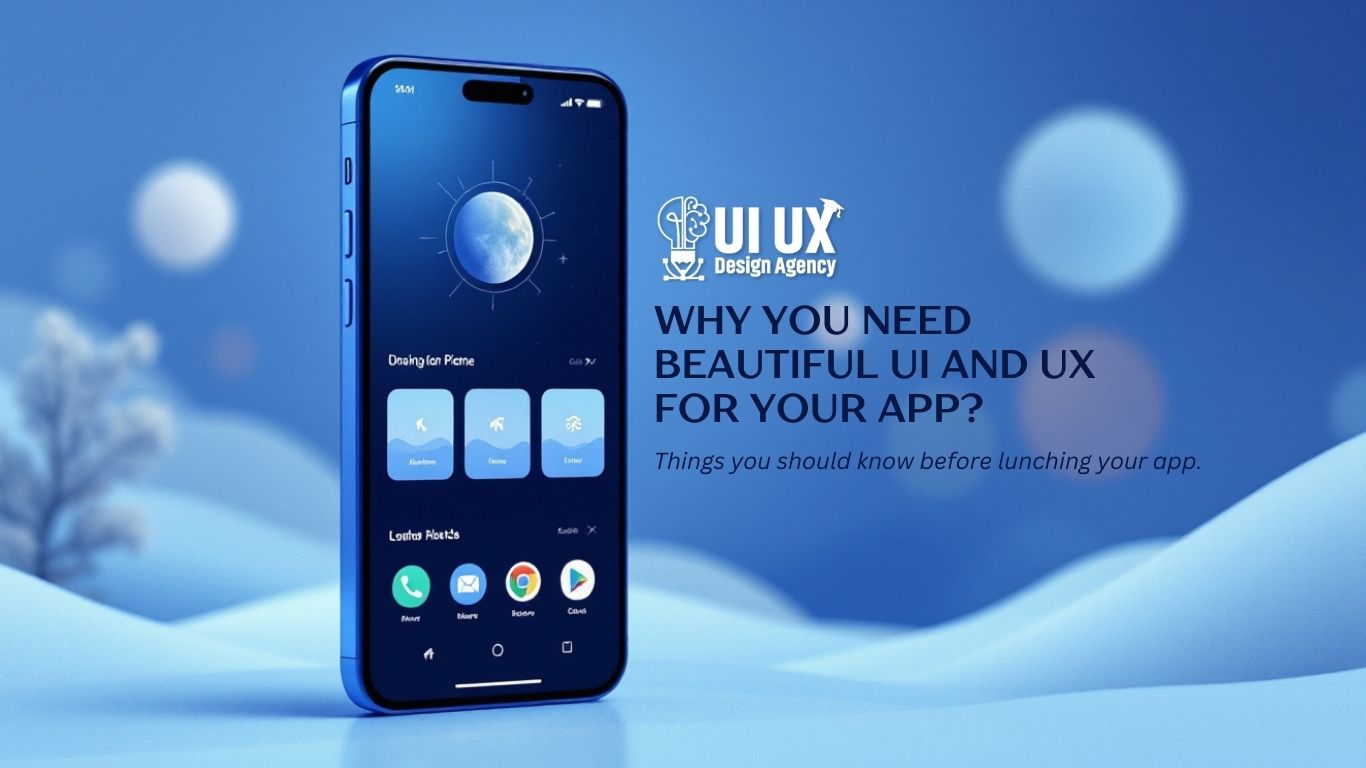
“Design is intelligence made visible.” — Alina Wheeler, Author of Designing Brand Identity.
In today’s world, is a functional app really enough? Not quite. If you want to truly connect with your users and build long term relationships, you need to focus on your app’s UI and UX. But why is design so crucial? And what should you consider before launching? In this guide, we’ll break down the essentials of great UI and UX and share what to keep in mind as you bring your app to life.
Why UI/UX Design Matters
“You never get a second chance to make a first impression.” — Will Roger, American actor.
We live in an application saturated cyber world whether web or mobile. Today first impressions can make or demolish your business app’s success. Imagine you download a new app. There only to find a confusing layout, unclear buttons, or slow-loading screens. You would quickly uninstall it and look for an alternative. This is why UI (User Interface) and UX (User Experience) design aren’t just “nice-to-haves”—they’re must-haves for any app which going to succeed and make money for creators.
A well-designed UI is like a known local store that welcomes users in with a familiar smile, while effective UX is what keeps them coming back. You want customer loyalty? Research shows that a strong user experience can increase customer loyalty by up to 15%. In other words, if your app looks appealing and functions smoothly, users are far more likely to engage or stay in your app. And even nice experience can recommend your app to others by current user, which is crucial of business growth.
Good UI/UX design doesn’t just improve the look and feel of an app—it directly impacts your brand’s credibility. Users are more likely to trust and invest in a service that values their experience. From easy navigation to well-placed calls to action, each design choice contributes to how users perceive your brand and whether they’ll stick around. If you’re serious about building an app that people love, putting time into your UI/UX is essential. After all, design isn’t just about making things look good; it’s also about making your users feel good.
How A Good UI/UX Enhances Customer Retention
Imagine using a habit tracing app that has everything you need: personalized notification system, easy tracking, and a way to share your progress with friends. However, if every time I open the app and face cluttered screens, hard-to-find buttons, and confusing icons. After a few frustrating attempts, I won’t come back to that thing! I might convince myself it’s not worth the hassle! Then switch to a simpler app.
Now let’s imagine the flip side. A clean interface with colorful dashboard where showing your daily goals, past history and simple button to log new data. Notifications are helpful but not overwhelming, and you can customize settings to match your needs. By giving you the feel of progress day by day this app will boost your happiness. This seamless, user-friendly experience doesn’t just help you reach your goals—it keeps you engaged with the app, making it part of your daily routine.

When an app is designed with user needs in mind, it makes people feel understood and valued, encouraging them to keep coming back. Good UI/UX minimizes frustration and enhances usability, creating a positive loop: the more users enjoy their experience, the more likely they are to stay engaged, return, and even recommend the app to others.
In the end, a well-designed app doesn’t just attract users—it keeps them. This is the power of good UI/UX in fostering loyalty and retention.
How UI/UX Boosts Conversion Rates
Good UI/UX design doesn’t just improve user satisfaction—it can directly impact your bottom line by increasing conversions. Think about an e-commerce app where users come to browse and make purchases. Now, imagine the app has a cluttered layout, unclear checkout process, and unexpected errors. Many users would just kill the app, costing the business potential sales. Who has time to figure out your app’s complex riddle?
Now consider an app where every step of the purchasing journey is clear. As a user browses products, they find clear images, concise descriptions, and a smooth scrolling experience. When they’re ready to purchase, the checkout button is easy to spot, and the process is straightforward with minimal steps. They won’t feel dumb. Adding options like guest checkout, clear payment methods, and a progress bar reassures the user that they’re on the right track, encouraging them to complete the purchase.
In fact, studies show that a well-designed UX can improve conversion rates by up to 200%. This is because users are more likely to follow through with actions (like signing up or making a purchase) when they encounter a seamless experience that meets their expectations.
Good UI/UX is about reducing friction and guiding users to their goals. When you make it easy for users to act, you’re not only enhancing their experience—you’re also boosting conversions and driving real business growth.
UI/UX Best Practices for Retention and Conversion
“Simplicity is the ultimate sophistication.” — Leonardo da Vinci
To create an app that users love and willing to spend money, following proven UI/UX best practices can make a significant difference in retention. It also helps to increase conversion rates. Here are some essential practices to keep in mind:
Simplicity and Clarity
Users shouldn’t have to guess their way around your app. Keep the design simple and intuitive, with clear buttons, familiar icons, and concise text. Avoid clutter by including only necessary elements on each screen. A clean, straightforward layout not only improves the user experience but also encourages users to stay longer. There is a saying, time is money. If you can capture customers time, then you can encourage them to spend money on your app, isn’t it?
Prioritize Speed and Performance
Only 2 second lag can drive users away. Optimize your app to ensure quick response times and smooth transitions between screens. Quick-loading apps make users feel that their time is respected, which encourages repeat visits and ultimately supports conversions and generating money though app.
Consistent Visual Design
Consistency in colors, fonts, and layouts creates a professional feel. Users find it easier to navigate when they recognize familiar design patterns and branding throughout the app. Consistent design also reinforces your brand identity, building trust and reliability over time. We human are feel confident roaming familiar land. So, consistent design is like a visual candy to the customers.
Effective Onboarding
A well-designed onboarding experience helps users understand your app’s value quickly and efficiently. Keep it simple by highlighting only the main features and making the process interactive. Good onboarding increases the likelihood of user retention. It sets positive experience from the first glimpse of your app.
Use of Clear CTAs (Call-to-Actions)
Call-to-action buttons should stand out, be strategically placed, and guide users through desired actions like signing up, upgrading, or purchasing. The text on these buttons should be clear and action-oriented, such as “Get Started” or “Buy Now,” making it obvious what users can expect when they click.
Responsive and Accessible Design
Your app should look and perform well on all devices and be accessible to people with disabilities. Ensure that text is readable. Elements are large enough to tap. Colors has high-contrast. Accessible design not only expands your audience but also creates a positive experience for all users.
Continuous User Feedback and Iteration
User feedback is a must have in any app. You should know what users want. Where your app can improve. Use analytics to track user behavior, conduct regular surveys, or use in-app feedback forms. Iteratively refining your design based on user input ensures your app remains relevant, user-centered, and effective in driving both retention and conversions.

Conclusion
In a competitive market, making an app that stands out goes beyond just having good features; it requires careful design. A strong UI and UX are not just extras; they are crucial parts that affect every moment of the user experience, from the initial impression to lasting loyalty. By focusing on quality UI/UX design, you create an app that is not only attractive but also easy to use. It helps keep users engaged and increases conversions.
As you develop your app, keep in mind that a smooth experience makes users feel appreciated and understood, building trust in your brand. Whether it’s through easy navigation, quick loading times, or clear action prompts, every design decision plays a role in your app’s success.
In the end, UI/UX is more than just looks; it’s about creating connections, addressing needs, and providing value. By emphasizing design, you prepare your app for ongoing growth, turning new users into loyal customers who return again and again.

